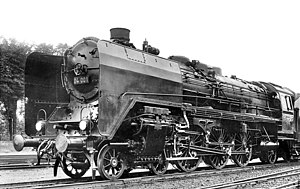DRG Class 04
| DRG Class 04/02.1 | |||||||||||||||||||||||||||||||||||||||||||||
|---|---|---|---|---|---|---|---|---|---|---|---|---|---|---|---|---|---|---|---|---|---|---|---|---|---|---|---|---|---|---|---|---|---|---|---|---|---|---|---|---|---|---|---|---|---|
 04 001 in 1932 | |||||||||||||||||||||||||||||||||||||||||||||
| |||||||||||||||||||||||||||||||||||||||||||||
| |||||||||||||||||||||||||||||||||||||||||||||
| |||||||||||||||||||||||||||||||||||||||||||||
| |||||||||||||||||||||||||||||||||||||||||||||
The two German Class 04 steam locomotives were experimental engines with the Deutsche Reichsbahn, that were derived from the Class 03 standard locomotives (Einheitsloks).
History[]
In 1932, the Deutsche Reichsbahn tried to raise boiler overpressures from 156.9 to 245.1 N/cm2 (227.6 to 355.5 psi) by using high-tensile steel. These engines, built by the firm of Krupp, were initially tested at the Grunewald Locomotive Testing Office. With a specific steam consumption value of 5.2 kg/PSh with respect to their indicated output, the locomotives clearly undercut the very low steam consumption value of the Class 03 by over 1 kg/PSh. The coal consumption based on the effective power at the coupling hook, was 0.96 kg/PSh compared with 1.13 kg/PSh on the 03.[1]
The medium-pressure boilers did not prove to be stable, and after a short time damage occurred to the firebox. Since the locomotives did not meet expectations even after modifications and repairs, the permissible boiler overpressure was finally reduced to 20 atmospheres in 1935 and they were added to the operating portfolio with the company numbers 02 101 and 02 102. They were then intended to be used in regular train service from the Hamburg-Altona depot, but since they had no experience with four-cylinder compound locomotives there, they were handed over to the Hof depot in 1936. Due to a lack of water, the boiler of 02 101 exploded on 3 April 1939,[2] whereupon both engines were decommissioned and were scrapped in 1940.
The engines were equipped with a 2'2' T 32 standard tender.
See also[]
References[]
- ^ Autorenkollektiv Johannes Schwarze, Werner Deinert, Lothar Frase, Heinz Lange, Oskar Schmidt, Georg Thumstädter, Max Wilke: Die Dampflokomotive. Entwicklung, Aufbau, Wirkungsweise, Bedienung und Instandhaltung sowie Lokomotivschäden und ihre Beseitigung. Reprint of the 2nd edn. of 1965 by Transpress Verlag, Stuttgart 1998, ISBN 3-344-70791-4, Table in Annex 1.1
- ^ "Albert Gieseler -- Dampflokomotive 04 001".
- Weisbrod, Manfred; Müller, Hans; Petznik, Wolfgang (1976). Dampflokomotiven deutscher Eisenbahnen, Baureihe 01–39 (EFA 1.1) (in German) (3rd ed.). Düsseldorf: Alba Buchverlag. pp. 53–55. ISBN 3-87094-081-6.
- Steam locomotives of Germany
- 4-6-2 locomotives
- Deutsche Reichsbahn-Gesellschaft locomotives
- Krupp locomotives
- Railway locomotives introduced in 1932
- Standard gauge locomotives of Germany
- 2′C1′ h4v locomotives
- Passenger locomotives